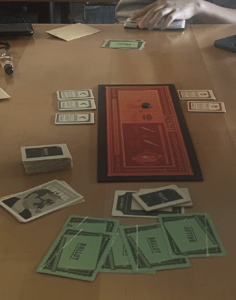For my first critical play, I played Secret Hitler by creator Max Temkin in a board game format. The game is targeted at individuals older than 17 years old because you have to know about fascism, liberalism, and nazism. It seems that this game is targeted at liberal Americans because they are portrayed as the “good guys” during the game while fascists and Hitler are portrayed as the “bad guys.” This type of political game would not be welcome in certain countries like Italy where there has been a huge rise of fascism in modern popular culture.

Important Formal Elements of the Game
The game is comfortably played with 5-10 people. It is a social deduction game because players are assigned to be either Hitler, fascists, or liberals but don’t know the role assignment of other players. The objective of the game is to discover the secret Hitler that is hiding in the fascist party while eliminating members of the opposing team. The procedure is that in each round, players elect a President and Chancellor through popular vote. The President draws three policies to implement for the group that are either liberal or fascist and discards one. The Chancellor then enacts one out of the two policies from the cards the President had previously approved. The outcome of the game is that the liberals win when they achieve 5 liberal policies whereas the fascists win when they achieve 6 fascist policies or Hitler becomes Chancellor when there are more than 4 fascist policies in the game. In this game, players play in Team vs Team but without knowing who is on their team. An interesting relationship is created during the game because there are two opposing teams that have a vested interest in eliminating the other team but are also not being discovered. The conflict between the objectives of eliminating the other team members while continuing to be deception leads to complex gameplay. Certain resources players have include policy cards and the ability to vote “yes” or “no” to each slate of President/Chancellor. The boundaries of the game are controlled by a game board that determines certain actions the President can take as the game progresses. Players cannot act outside of the rules dictated by the gameboard.

Comparison to Other Games
This game is very similar to other social deception games, most notably Mafia. The aesthetics of this game are very different from Mafia, however, because the game places the players in an unstable 1932 government. Additionally, unlike Mafia, there is not as much room for consensus and voting out suspicious players because ultimately the president gets to kill players in this game as dictated by the game board. The president can ask for opinions from the group but ultimately get final say in their action. Because of these constraints, this game is much more fun than Mafia. The new rules accelerated gameplay which contrasts the long, drawn-out nature of Mafia. Due to the game board and the desired outcomes of the game, Secret Hitler will always reach an endgame.

Types of Fun
The game was fun because there was Fellowship, Challenge, and Narrative. The Narrative was particularly compelling to my team and a lot of us were “acting” our roles. For me as Secret Hitler, it was fun acting surprised when new policies were implemented as a way to manipulate the liberals. The fellowship of protecting your team and the challenge of identifying opposing and eliminating other team parties kept me engaged. When I was Secret Hitler, the fellowship with my fellow fascists was extremely fun. I had a hunch about who were the fascists and I secretly elected them to power so that we could implement more fascist policies.
Moments of Success / Failure
Moments of particular success were when the fascists would do “liberal” moves to avoid being accused of being “fascists” early on in the game so that later in the game they could deceive the liberals when it mattered more. A moment of failure throughout the game was voting on President/Chancellor slates. Throughout most of the game, the entire group would vote “yes” on the slate because there wasn’t much discussion/consensus on who was acting suspiciously each round. Therefore, the default action was to vote “yes” on each slate which means that we didn’t get to the discovery of the Secret Hitler until near the end of the game when the game board imposed restrictions or the beginning of an end game.

Things I would change
To make the game better, I would accelerate gameplay even more by making the “red zone” on the board aspect of Secret Earlier earlier on in the game. For the first two rounds, there was not much buy-in to the game because there were no tangible consequences. Another thing I would add is the ability to bring back players that have been killed off as an option for presidential action (almost like a pardon) to bring more voices back into the table at crucial and tense times. By adding this resource, we can increase the conflict within the game which makes it more engaging overall. As mentioned in the failures, I would also create room for discussion before each ballot vote rather than members voting in silence. By creating more opportunities for consensus, members can begin the social deduction earlier in the game without having to rely on the game board at the end and experiencing engagement toward the end of the game. Overall, I think the game can strengthen its fellowship by creating opportunities for consensus even when the President makes unilateral decisions about who gets to be eliminated. This makes each player feel like they have a vested interest in the game during each round, instead of feeling like a passive player in rounds where they are not in the ruling slate.
All in all, this was a great first experience playing Secret Hitler and I had a ton of fun.



